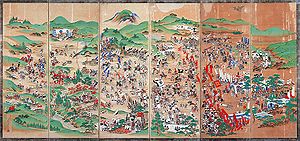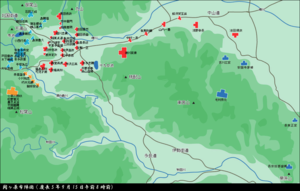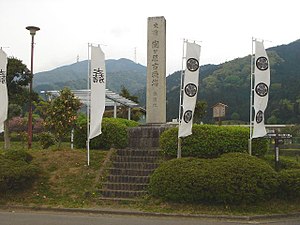Battle of Sekigahara
| Battle of Sekigahara | |||||||||
|---|---|---|---|---|---|---|---|---|---|
| Part of the Sengoku period | |||||||||
 Edo period screen depicting the battle. | |||||||||
| |||||||||
| Belligerents | |||||||||
| Forces loyal to Toyotomi Hideyori, many clans from Western Japan | Forces of Tokugawa Ieyasu, Clans of Eastern Japan | ||||||||
| Commanders and leaders | |||||||||
| Ishida Mitsunari, Mōri Terumoto, others | Tokugawa Ieyasu, others | ||||||||
| Strength | |||||||||
| Approximately 100000[citation needed] | Approximately 80000[citation needed] | ||||||||
| Casualties and losses | |||||||||
|
5000-32000 dead Otani Yoshitsugu Shimazu Toyohisa | Unknown; but not excessive | ||||||||
The Battle of Sekigahara (Shinjitai: 関ヶ原の戦い; Kyūjitai: 關ヶ原の戰ひ, Sekigahara no Tatakai), popularly known as the Realm Divide (天下分け目の戦い, Tenka Wakeme no Tatakai), was a decisive battle on September 15 1600 that cleared the path to the Shogunate for Tokugawa Ieyasu. Though it would take three more years for Ieyasu to consolidate his position of power over the Toyotomi clan and the daimyo, Sekigahara is widely considered to be the unofficial beginning of the Tokugawa bakufu, the last shogunate to control Japan.
At what is now Sekigahara, Gifu Prefecture, forces loyal to Tokugawa Ieyasu's forces battled those led by Ishida Mitsunari, who was loyal to Toyotomi Hideyoshi's son and designated heir, Hideyori. The tide of the battle turned when Kobayakawa Hideaki on Mitsunari's side betrayed his allies during the fight. Although at first Kobayakawa merely stood on the sidelines of the battle, not taking part in the battle, Ieyasu eventually ordered his ashigaru to fire at Kobayakawa's troops, after which Kobayakawa began fighting on Ieyasu's side. Kobayakawa's betrayal plus the betrayal of other samurai under Mitsunari is what led to Ieyasu's decisive victory and a temporary end to fighting.
Background and pretext
Even though Toyotomi Hideyoshi unified Japan and consolidated his power following the Siege of Odawara in 1590, his ill-fated invasion of Korea significantly weakened the Toyotomi clan's power as well as the loyalists that continued to serve and support the Toyotomi clan after Hideyoshi's death. The war also worsened the continuous conflict between the army commanders and the bureaucrats under Hideyoshi. The presence of Hideyoshi and his brother, Hidenaga kept the two sides from anything more than quarreling, but when both of them died, the conflicts were exacerbated and developed into open hostilities. Since the Toyotomi clan was known to be descended from peasant stock, neither Hideyoshi nor anyone in his family would be recognized or accepted as Shogun. Later on, Maeda Toshiie's death removed any trace or pretense of friendliness between the two sides.
Most notably, Kato Kiyomasa and Fukushima Masanori were publicly critical of the bureaucrats, especially Ishida Mitsunari and Konishi Yukinaga. Tokugawa Ieyasu took advantage of this situation, and recruited them, redirecting the animosity to weaken the Toyotomi clan.
Beginning
Tokugawa Ieyasu was no longer rivaled in terms of seniority, rank, reputation and overall influence within the Toyotomi clan after the death of Regent Toshiie. Rumors started to spread stating that Ieyasu, the only surviving ally of Oda Nobunaga, would take over Hideyoshi's legacy just as Nobunaga's was taken. This was especially evident amongst the loyalist bureaucrats, who suspected Ieyasu of agitating unrest amongst Toyotomi's former vassals.
Later, a supposed conspiracy to assassinate Ieyasu surfaced, and many Toyotomi loyalists, including Toshiie's son, Toshinaga, were accused of taking part and forced to submit to Ieyasu's authority. However, Uesugi Kagekatsu, one of Hideyoshi's appointed regents, defied Ieyasu by building up his military. When Ieyasu officially condemned him and demanded that he come to Kyoto to explain himself before the emperor, Kagekatsu's chief advisor, Naoe Kanetsugu responded with a counter-condemnation that mocked Ieyasu's abuses and violations of Hideyoshi's rules, in such a way that Ieyasu was infuriated.
Afterwards, Ieyasu summoned the help of various supporters and led them northward to attack the Uesugi clan, which at that moment were besieging Hasedō, but Ishida Mitsunari, grasping the opportunity, rose up in response and created an alliance to challenge the Ieyasu's supporters, also seizing various daimyo's as hostages in Osaka Castle.
Ieyasu then left some forces led by Date Masamune to keep the Uesugi in check and marched west to confront the western forces. A few daimyo, most notably Sanada Masayuki, left Ieyasu's alliance, although most, either bearing grudges against Mitsunari or being loyal to Ieyasu, stayed with him.
While they did send troops later on, the Toyotomi clan did not take part in this battle and officially condone any side.
The battle
Mitsunari, in his home Sawayama Castle, met with Otani Yoshitsugu, Mashita Nagamori, and Ankokuji Ekei. Here, they forged the alliance, and invited Mori Terumoto to be its head, although Terumoto actually distanced himself from the fighting.
Mitsunari then officially declared war on Ieyasu and lay siege to the Fushimi Castle, garrisoned by Tokugawa retainer Torii Mototada on July 19. Afterwards, the western forces captured various Tokugawa outposts in the Kansai region and within a month, the western forces had moved into the Mino province, where Sekigahara was located.

Back in Edo, Ieyasu received news of the situation in Kansai and decided to deploy his forces. He had some former Toyotomi daimyo engage with the western forces while he split his troops and marched west onTōkaidō towards Osaka Castle.
Ieyasu's son Hidetada led another group through Nakasendō. However, Hidetada's forces were bogged down as he attempted to besiege Sanada Masayuki's Ueda Castle. Even though the Tokugawa forces numbered some 38,000, an overwhelming advantage over the Sanada's mere 2,000, they were still unable to capture the strategist's well-defended position. At the same time, 15,000 Toyotomi troops were being held up by 500 troops under Hosokawa Fujitaka at Tanabe Casle in the Wakayama prefecture. Some among the 15,000 troops respected Hosokawa so much they intentionally slowed their pace down. Both these incidents resulted in a large number of Tokugawa and Toyotomi troops not to show up in time at the battlefield of Sekigahara.
Knowing that Ieyasu was heading toward Osaka, Mitsunari decided to abandon his positions and marched to Sekigahara. On September 15, the two sides started to deploy their forces. The eastern army had 88,888 men, whilst the western army numbered 81,890.

Even though the western forces had tremendous tactical advantages, Ieyasu had already contacted many daimyo on the western side, promising them land and leniency after the battle should they switch sides. This led some western commanders holding key positions to hesitate when pressed to send in reinforcements or join the battle that was already in progress.
Mori Hidemoto and Kobayakawa Hideaki were two such daimyo. They were in such positions that if they decided to close in on the eastern forces, they would in fact have Ieyasu surrounded on three sides. Hidemoto, shaken by Ieyasu's promises, also persuaded Kikkawa Hiroie not to take part in the battle.
Even though Kobayakawa had responded to Ieyasu's call, he remained hesitant and neutral. As the battle grew more intense, Ieyasu finally ordered arquebusiers to fire at Kobayakawa's position on Mount Matsuo. At that point Kobayakawa joined the battle on eastern side. His forces assaulted Yoshitsugu's position, which quickly fell apart as he was already engaging Todo Takatora's forces. Seeing this as an act of treachery, western generals such as Wakisaka Yasuharu, Ogawa Suketada, Akaza Naoyasu, and Kutsuki Mototsuna immediately switched sides, turning the tide of battle.
The western forces disintegrated afterwards, and the commanders scattered and fled. Some, like Ukita Hideie managed to escape, while others, like Yoshitsugu committed suicide. Mitsunari, Yukinaga and Ekei were some of those who were captured and a few, like Terumto and Shimazu Yoshihiro were able to return to their home provinces.
Rise of the Tokugawa Shogunate

Tokugawa Ieyasu redistributed the lands and fiefs of the participants, generally rewarding those who assisted him and displacing, punishing, or exiling those who fought against him. In doing so, he gained control of many former Toyotomi territories. After the public execution of Ishida Mitsunari, Konishi Yukinaga and Ankokuji Ekei, the influence and reputation of the Toyotomi clan and its remaining loyalists drastically decreased. From the Toyotomi clan's point of view, the battle was technically only an internal conflict between Toyotomi vassals. Ieyasu however was later made Shogun, a position that had been left vacant since the fall of the Ashikaga shogunate. This change in official ranks also reversed the subordinate position of the Tokugawa clan. In any case, Ieyasu did not gain any casus belli to take action against the frail Toyotomi clan; rather, it would take more political maneuvers for Ieyasu to destroy Hideyori once and for all.
The Mori, Shimazu and Chosokabe
While most clans were content with their new status, there were many clans, especially those on the western side, who became bitter about their displacement or what they saw as a dishonorable defeat or punishment. Three clans in particular did not take the aftermath of Sekigahara lightly:
- The Mori clan, headed by Mori Terumoto, remained angry toward the Tokugawa shogunate for being displaced from their fief, Aki, and being relocated to the Chōshū Domain because the clan never actually took part in the battle.
- The Shimazu clan, headed by Shimazu Yoshihiro, blamed the defeat on its poor intelligence-gathering. While they were not displaced from their home province, Satsuma, they did not become completely loyal to the Tokugawa shogunate either. Taking advantage of its large distance from the capital as well as its improved espionage, Satsuma, near the end of the Tokugawa shogunate, demonstrated that it was virtually an autonomous kingdom independent from the Tokugawa shogunate.
- The Chosokabe clan, headed by Chosokabe Morichika, was stripped of its title and domain of Tosa and sent into exile. Former Chosokabe retainers never quite came to terms with the new ruling family, the Yamauchi clan. In fact, the Yamauchi clan made a distinction between its own retainers and former Chosokabe retainers, giving them lesser status as well as discriminating treatment. This class distinction continued even generations after the fall of the Chosokabe clan.
The descendants of these three clans would in two centuries collaborate to bring down the Tokugawa shogunate.
Miyamoto Musashi
- According to tradition, the legendary kensei Miyamoto Musashi was present at the battle among the ranks of Ukita Hideie's army. Supposedly, he fought well and escaped the defeat of Hideie's forces unharmed. Whether this is fact or myth is unknown; Musashi would have been around 16 years of age at the time.
Appearances in popular culture
- This battle is the main fighting scene in the film Sengoku jieitai 1549 (2005). The film also reveals some of the main characters and political situation, which is a little perverted by the film plot.
- This battle figures prominently in the manga and anime series Samurai Deeper Kyo.
- The battle appears in the video games Kessen and Samurai Warriors 2 for the Playstation 2. The latter actually is the object of many what-if scenarios, some of which turns the tide of the battle resulting in victory for the Western army.
- The battle will also be featured in Age of Empires III: The Asian Dynasties as part of the Japanese campaign.
- This battle appears in Shogun: Total War as one of the historic battles for the PC.
- In Azumi, the Battle of Sekigahara is a major plot element.
- James Clavell's best-selling novel "Shogun" depicts the events leading up to this climatic battle, although the battle itself is only referred to in a short two-paragraph postscript.
- The 2003 mini-series Musashi begins with a young Miyamoto Musashi emerging from beneath numerous corpses in the aftermath of Sekigahara.
External links
- SengokuDaimyo.com The website of Samurai Author and Historian Anthony J. Bryant
- Anthony J. Bryant is the author of Sekigahara 1600: The Final Struggle for Power, Praeger Publishers;(September, 2005)
- A strategy war game based on the battle: Sekigahara: Unification of Japan
